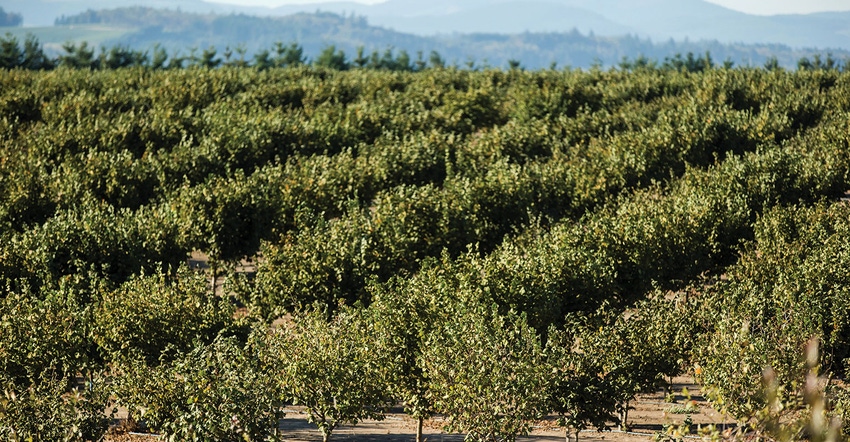
Good news and bad news this spring if you’re a hazelnut grower in the Pacific Northwest, specifically in the Salem, Ore., area.
With pollination accomplished and buds beginning to bloom on branches, some Willamette Valley orchards got struck with ice damage in February, what one grower called “the worst orchard ice I��’ve seen.” Some trees lost limbs, others cracked in half or toppled over under the added frozen weight.
“Although we get them from time to time, this was a pretty unique ice storm because it was fairly localized,” said Jason Perrott of the Nut Growers Society, himself a grower on 110 acres near Eugene.
“We didn’t have any ice at all, in fact, our temperatures were some 20 degrees higher than around the Salem area where they had some pretty serious problems because of ice build-up,” he said. “Younger trees lean better with that kind of added weight, but the older, more established orchards tend to be more brittle as they get taller, building up more capture area for snow and ice and you tend to get more failures.”
Some of the Salem-area damage was classified as serious. “Some of those trees, especially the older Barcelona variety, had quite a bit of damage in the aging declining orchards, perhaps as much as 50-60% suffering as a result of the storm,” he said. “Again, that damage was localized and isolated and not across the state. So there may be some short-term pain and lost production this year, but this may also provide a jump start to plant some newer and stronger varieties.“
Good news, too
That’s what qualifies as the bad news -- and there’s plenty of good news, too.
“Our flowers got pollinated, a bit later than usual, so things are normal in that area,” Perrott said. “Our Jefferson varieties pushed out maybe a bit behind normal schedule this year with leaves showing up by early-to-mid-April with no overwinter damage reported down in the South Valley.”
Wintertime activities, like pruning, got done as they usually do. “We actually had a big year because we have a double-density planting and as trees reach a certain age, they become too crowded and every other tree gets removed, so there was quite a bit of tree removal and cleanup to be done and it went well,” he said.
“The focus now is on our spring work schedule, getting things like drip lines rolled out and flushed and blight sprays ready to go.”
Because different varieties of hazelnuts have different timing, Jefferson’s, a newer variety developed to be a replacement for Barcelona’s, are coming in a bit behind the Colonial varieties which should be popping out about now. “We have some McDonald’s as well that started to leaf out a couple of weeks ago,” Perrott said.
As to final 2020 harvest count: “I haven’t heard the actual final tally, but from everyone’s take, last season should be a record.”
But the biggest of the Good News came in the form of an announcement about the Summer Tour which had to be cancelled in 2020 due to COVID-19 concerns, the first such cancellation in its 60-year history.
“We’ll be doing the Summer Tour, a combination of a field tour (at the Perrott farm in Coburg) with presentations and a trade show on August 4,” he said. “There’s been a tremendous growth in the industry, especially over the last 10 years, so there’s definitely a sense of optimism and excitement about growth prospects.”
For more news on tree nuts as reported by growers and farm advisors, subscribe to the Tree Nut Farm Press e-newsletter.
About the Author(s)
You May Also Like




